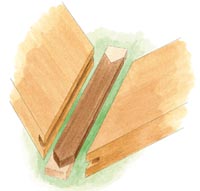
Q: I thought the recommended practice was to cut splines crossgrain to add strength, since wood breaks too easily with the grain, but in a Woodworker’s Journal piece, they showed long grain splines in miter joints in a frame. Shouldn’t they have been crossgrain?
Richard Jones: A spline offers additional strength whichever way it’s orientated, but a crossgrain spline is probably more common.
Michael Price: The main purpose of splines or slip feathers is to strengthen an end grain joint. Accordingly, splines should always have their grain running perpendicular to the joint. Any other grain placement will provide a weaker joint.
Tim Inman: Opposing grain directions in spline joints does indeed yield the strongest joint reinforcement.
Michael Dresdner: A spline in a mitered frame is there mostly to provide gluing surface, since without it, you are trying to glue end grain to end grain. Since a mitered frame is not a joint meant to take a lot of stress in the first place, the spline grain direction is less critical than it would be in a more stressed joint. That’s especially true where the miter frame is reinforced in some other way, such as when the frame is housing for a panel or is attached to a case.





